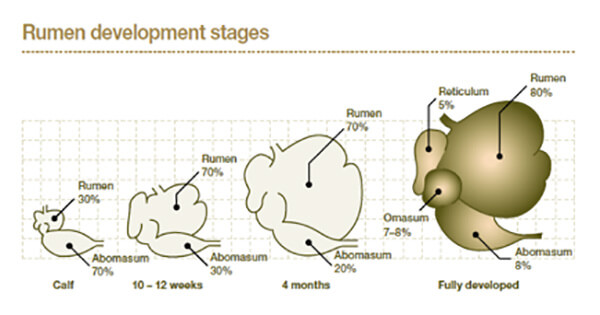Weaning is the process of transferring a calf from a liquid milk diet to a completely ‘solid’ based diet. Successful weaning is dependent on ensuring that a calf’s digestive system is well set up for processing bulky high fibre pasture and the decisions you make in the pre-weaning period can have a significant impact on how well calves will flourish once their milk is taken away.
Rumen development during the calf rearing process can be achieved by offering a high quality hard feed to calves from an early age and ensuring systems are set up to successfully achieve good calf intake of a hard feed by weaning time. A good quality hard calf feed will include starch, which encourages papillae development in the rumen and the establishment of a microflora population essential for the fermentation of high fibre feeds.

Weaning can be a stressful time for calves particularly if the decision to wean is made prematurely. If the rumen is not properly prepared for digesting pasture, calves can go backwards very quickly and lose condition fast as they simply don’t yet have the ability to get the sufficient levels of energy and protein out of the grass.
Making the decision to wean can be made easier by setting targets that must be met before a calf can be weaned. Age or weight alone are not the best parameters to use as they do not assess rumen development. A better parameter to assess is hard feed intake in combination with having a weight target specific to a farm.
Rule of thumb: When a calf is eating 1-1.5kg (depending on the calf breed) of hard feed for three consecutive days it is ready to be weaned the calf is telling us that the rumen is sufficiently developed.
Top tips for weaning
- Do not wean calves during period of additional stress e.g. illness, dehorning or extreme weather.
- Weigh calves regularly
- Gradually wean calves rather than abruptly removing them off milk. (Gradually reduce volume per feed and/or number of feeds a day to smoothen the change)
- Be prepared to hold calves back from weaning if they are not eating enough hard feed – they are telling you their rumens are not ready yet.
- Assess the level of milk in your system if intake of hard feed is low (over feeding of milk can reduce intake of hard feed)
- Continue to feed hard feed after weaning has occurred. This helps to support growth rates in the newly weaned calf. Some farmers find it beneficial to continue feeding hard feed for several weeks/months post weaning, particularly if pasture quality/quantity is poor. Post weaning calves at pasture have been found to grow faster on 16{a6cf720711b426c9473e32c32c90b3654546aee744692ad9b05ec4813aa41846} crude protein calf pellets rather than barley, however continuing to feed 20{a6cf720711b426c9473e32c32c90b3654546aee744692ad9b05ec4813aa41846} crude protein pellets may be advantageous.
- Coccidia challenge is most likely to be highest in the 8 weeks following weaning. Calves take time to build up resistance to coccidiosis and may benefit from being fed a coccidoistat in pellets for some weeks post weaning off milk.
Grass quality and quantity can affect calf growth through the summer so it can be false economy to cut back on hard feed too early in the spring when there is an opportunity to keep growth on-track
Article Supplied by Stacey Cosnett
Nutritionist,
Farmlands Nutrition
027 778 4499

